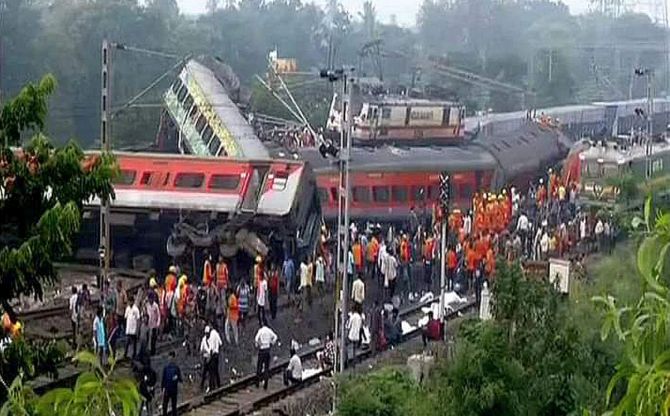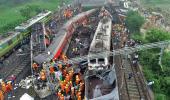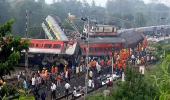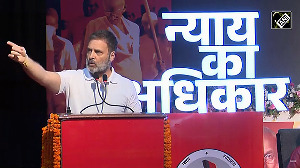Investigators were on Saturday looking into any human error, signal failure and other possible causes behind the three-train crash in Odisha's Balasore district as officials submitted a preliminary inquiry report into the worst rail accident in India in nearly three decades that left at least 288 people dead and over 1,100 injured.

The crash involving Bengaluru-Howrah Superfast Express and Shalimar-Chennai Central Coromandel Express, which were carrying around 2,000 passengers, and a goods train occurred around 7 pm on Friday near the Bahanaga Bazar station in Balasore, about 250 km south of Kolkata and 170 km north of Bhubaneswar.
Seventeen coaches were derailed and severely damaged in the accident, trapping hundreds of passengers. Both passenger trains were at a high speed and it has been cited by experts as one of the main reasons for the high number of casualties.
The rescue operation was wrapped up Saturday afternoon and restoration work started. The injured were admitted to four hospitals.
Preliminary investigations have revealed that a signal was given to Coromandel Express to enter the main line but it was taken off and the train entered the loop line, where it crashed into a goods train parked there.
The Bengaluru-Howrah Superfast Express which was coming at high speed crashed into the coaches of Coromandel Express that had scattered on the adjacent track.
Citing reports till Saturday evening, officials said 288 people were killed in the accident.
As many as 1,175 people were admitted at various hospitals, including private ones, out of which 793 have been released and 382 were undergoing treatment, Odisha government officials said at around 8 PM Saturday.
All except two patients are stable, they said.
Shocked survivors recalled their brush with death, while families in several states including West Bengal, Tamil Nadu and Odisha underwent a painful wait to know the fate of their loved ones.
"The train was running at a high speed. Around 7 pm, a loud sound was heard and it was chaos after that. I fell on the floor from the upper berth. It was ghastly, many people with grave injuries were lying around," Mizan Ul Haq, a resident of Bardhaman who was in a coach at the rear of the Howrah Superfast Express train, told PTI.
Another Bardhaman resident, a carpenter who works in Bengaluru, said he was injured in the chest, feet and head when the coach in which he was travelling turned turtle. "We had to break open the windows and jump out of the compartment to save ourselves," he said, adding he saw many bodies after the accident.
The unreserved compartments were packed, carrying mostly migrant workers to Tamil Nadu or Kerala, according to survivors.
While questions were raised on why the anti-train collision system "Kavach" did not work, the railways said it was not available on the route.
The national transporter has initiated a high-level probe into the train that will be headed by the commissioner of railway safety, South Eastern Circle, officials said.
While sources had earlier said a signalling failure could be the reason behind the crash, railway officials said it is not yet clear if Coromandel Express entered the loop line and hit the stationary goods train or it first derailed and then hit the parked train after entering the loop line.
The preliminary inquiry report, a copy of which is with PTI, said the signal "was given and taken off for the up main line for train number 12841 but the train entered the up loop line and dashed with the goods train which was on the loopline and derailed".
"In the meantime, (train number) 12864 passed through the down main line and two coaches of it derailed and capsized."
The loop lines of the Indian Railways are constructed in a station area -- in this case, the Bahanagar Bazar station -- to accommodate more trains to ease out the operations.
The loop lines are generally 750 metres in length to accommodate full-length goods train with multiple engines.
While Coromandel Express was at a speed of 128 kmph, Bengaluru-Howrah Superfast Express was running at a speed of 116 kmph. The report has been submitted to the Railway Board, sources said.
These trains generally run up to a maximum speed of 130 kmph.
"A M Chowdhary, CRS, SE Circle, will inquire into the accident," a spokesperson of the Indian Railways said.
None of the authorities has so far talked about any possibility of sabotage.
"The rescue operation has been completed. Now, we are starting the restoration work. Kavach was not available on this route," Indian Railways spokesperson Amitabh Sharma said.
The railway is in the process of installing "Kavach", an anti-train collision system, across its network.
Kavach alerts when a loco pilot jumps a signal (Signal Passed at Danger -- SPAD), which is the leading cause of train collisions. The system can alert the loco pilot, take control of the brakes and bring the train to a halt automatically when it notices another train on the same line within a prescribed distance.










 © 2025
© 2025